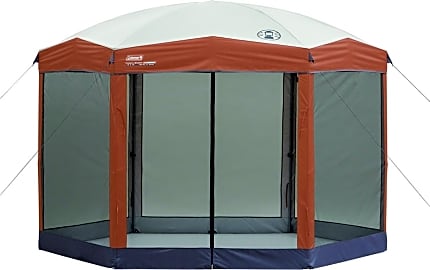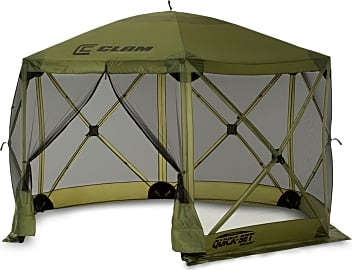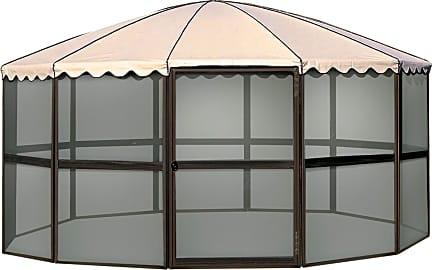The 10 Best Screen Houses

This wiki has been updated 35 times since it was first published in March of 2017. Ideal for camping or adding a protected space to your yard or patio, one of these convenient screen houses will come in handy during the warm, bug-ridden months. Our selection includes options made with durable frames and fade-resistant fabrics that can withstand harsh sunlight. Some offer adjustable heights and detachable roofs, and others allow for easy portability. When users buy our independently chosen editorial picks, we may earn commissions to help fund the Wiki.
Editor's Notes
September 04, 2020:
Many screen houses may look like tents, but it’s important to recognize that they typically only provide shade and shelter from bugs (not rain protection). If you require an overnight shelter for group camping, check out some tents.
Opted to remove a few items for various reasons, including poor durability and an inability to stand up to heavy winds and harsh weather. Adjusted the listing for the Casita Round to indicate that it folds down for storage, making it a bit easier to disassemble than many models out there. We also noted that the Clam Quick Set Escape Shelter includes stakes and tie-down ropes, which come in handy when conditions are windy.
We added several new items that vary in design, from a vast, stylish structure that can accommodate a large group to a compact “instant” screen house that pops up in as little as a few minutes. The Mekkapro Ultra is different from most items on the list in that there is no frame for setting it up as a freestanding structure. Instead, the netting comes with hangers, which can be attached to trees, poles and other surfaces to create a hanging shelter. If you’re handy, you could of course build your own frame out of PVC pipe or a similar material.
Though somewhat expensive, the Alvantor Gazebo is very spacious, and it’s one of the more elegant-looking options available.
April 17, 2019:
This wiki had a couple of duplicate Coleman and Casita-brand items that were very similar to one another, so I decided to pick one of each and add a few additional options.
Maintained the Coleman Back Home for its telescoping poles, ground stakes, and strong Polyguard fabric. Additionally, this option includes a wheeled carrying bag and convenient front/rear access doors for easy entry and exit. The Clam Quick Set Escape Shelter can accommodate several people, while its 3-layered corner pole pockets are ideal for withstanding constant use. The vinyl roof and grommets on the Casita Round make it well-adept at resisting mildew growth, while its frame withstands constant sun exposure without fading or rusting. It also comes with a patented cable retainer system. Despite the rather limited airflow, the tight-weave mesh on the Gazelle Hub still maintains itself as a worthy contender, particularly when used in camping spaces with a lot of biting insects. This structure's umbrella frame system means it can be assembled very quickly, which comes in handy if a storm is on the way and you don't want to have to fuss with complex instructions. Now, the Vango Cruz is one of the more original selections as I chose, as its pre-angled sections and bracer beams help reinforce its structural integrity, while its design lends itself well to attaching to trucks and motor homes. Its front awning is also quite useful for storing muddy clothes or shoes that you don't want to track inside. Perfect for sleeping under the stars, I also added the Luxe Tempo for the included sleeping mattresses and polyurethane exterior coating. Also included the Wenzel Magnetic for the hands-free entry and automatic closure system. Finally, I maintained the Patio Mate 09365 for its anchoring capabilities, detachable roof, and adjustable height.
Special Honors
Eureka! External After a long day of fishing or hiking, you’re probably looking forward to a hearty meal. You’ll be able to enjoy your food in peace with this solid screen house, which offers exceptional shade and a tight seal to prevent horseflies, bees and mosquitos from pestering you during relaxation time. eurekacamping.com
Kodiak Canvas It’s on the pricier side, but this rugged all-season model should stand the test of time, even after exposure to rough weather and harsh environments. Steel rods help keep the tent taut, and the sidewalls and windows can be zipped shut to keep out the rain if it starts storming. It comes with an organizer for stowing your gear as well. kodiakcanvas.com
Keeping The Bugs At Bay
A lot of people like to use chemicals to keep bugs away from them, like sprays or wearable devices.
Nobody likes bugs. Even professional entomologists, I suspect, deep down, get a chill up their spine from certain insects. I tried to like bugs. When I was 16, I watched Hayao Miyazaki’s Princess Mononoke, and the way he rendered flying insects in that film gave me a new appreciation for them. Little gnats like dust motes would flutter into the classrooms of my high school days, and I would watch the patterns they traced in the air like they were the hands of Jackson Pollock himself, all natural, improvisational beauty and expression. Well, that appreciation lasted about a month.
The reality is that insects are not our friends. We may share more symbiotic relationships with some than we’d care to admit, but symbiosis does not a friendship make. In some cases, the insects we encounter have the potential to do us real harm, as well. We don’t have to worry about things like Malaria so much in the US, both because it’s so incredibly rare, and because we have ready access to the medicines required to treat it. We do have to worry about things like West Nile virus, however, another disease carried by the dreaded mosquito. Incidences of West Nile have been on the rise over the last decade or so, and it can be very dangerous to children, the elderly, or anyone with a compromised immune system.
There are plenty of things you can do to try to keep bugs away from you when you’re outdoors, but most of these methods have unintended consequences, or they just don’t work well enough. Citronella candles, for example, boast the ability to keep mosquitoes from ruining your outdoor evening, but I’ve never been at a party with these particular light sources and not still gotten bit. They might mitigate the onslaught a little, but they’re far from foolproof.
A lot of people like to use chemicals to keep bugs away from them, like sprays or wearable devices. These actually work pretty well, but they’re also extremely dangerous to human health. Chronic exposure to these chemicals can result in everything from nausea and irritation in the eyes and skin to convulsions. What’s worse, many of those products are tested on beagles, so buying them contributes to an industry that’s actively abusing ridiculously adorable animals.
At the end of the day, the best solution might actually be the simplest: a screen house. Screen houses create a physical barrier that flying insects like bees or mosquitoes cannot cross. What’s even better is that they still allow you to enjoy the outdoors. You get just enough sun and all the breezes that nature can muster to keep you comfy and relaxed on those perfect summer days.
Which Screen House Is Right For You?
Once you’ve realized that the screen house is the ultimate outdoor party shelter, you still have to decide which one is right for you and your space. There are a lot of options out there that are suitable for different occasions and groups, so don’t feel pressured into buying just one, either. You may find use for a pair of different sized screen houses.
You may find use for a pair of different sized screen houses.
Some of the screen houses on our list can accommodate a few chairs and maybe a small table. They’re primarily intended for people to set up in their backyards for dinners with the immediate family, or to take to the beach to keep the sun and sand from whipping up and causing discomfort. If you have a big family, or you have a large event coming up like a 4th of July barbecue, you might need to invest in something a little bigger.
Whatever size your final purchase is, keep an eye on the size of its opening, as well. You’ll want to make sure that whatever table you want to set up in there can get through the door, otherwise you might have to build the screen house around it.
Another important consideration is assembly. If you know you’ll reliably have a second pair of hands like a dedicated spouse or an available teenage child, then one of the more complicated units on our list is a good idea. They tend to be a little sturdier once put together, so if you live in an area that suffers high winds, this might be a great idea. On the other hand, if you’re all alone in your setup because your significant other has to cook and your children have to do whatever it is they do online all day, then something that pops up quickly and easily is your best bet.
You might also need to look into the strength of a given screen material as you take in the items on our list. This is especially crucial if you have pets (maybe you rescued one of the bug spray beagles!) whose claws might tear at the screen.
A Brief History Of Screens
The screen as we know it is a relatively recent phenomenon. Today, we take it for granted that all our windows and doors will have some means by which to keep out insects and still allow in the breeze and a little sun. But that wasn’t a luxury afforded to our ancestors.
Today, we take it for granted that all our windows and doors will have some means by which to keep out insects and still allow in the breeze and a little sun.
In fact, screen windows only came about in the early part of the 19th century. These were made from woven metal, making them exceptionally strong, but also a little heavy and prone to rust. Some early manufacturers created them specifically for the tops of train cars, so that sunlight could reach the passengers, but dirt, soot, and debris would stay out.
Other industries experimented with screens, as well, most notably the food industry, where screens were employed primarily for straining purposes. Newer designs of screens are made out of everything from metal to fiberglass, and many styles are exceptionally easy to cut to size. That allows manufacturers to create all kinds of shapes and sizes of screen, and even to mold them into the houses you see here today.















